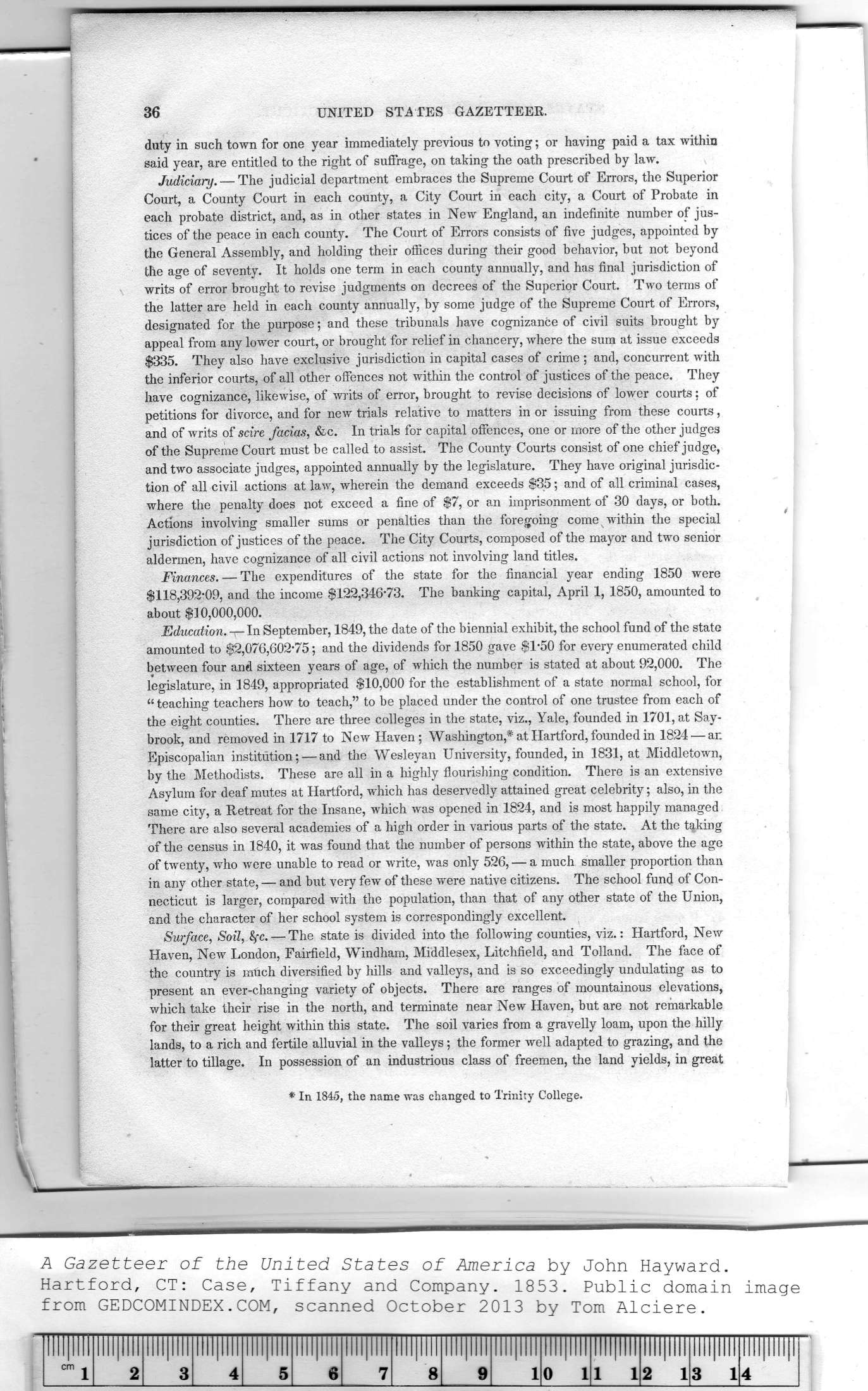|
|
Note: Ctrl and + increases the font size of the text below, Ctrl and - decreases it, and Ctrl and 0 resets it to default size.
36 UNITED STATES GAZETTEER.
duty in such town for one year immediately previous to voting; or having paid a tax within
said year, are entitled to the right of suffrage, on taking the oath prescribed by law.
Judiciary. — The judicial department embraces the Supreme Court of Errors, the Superior
Court, a County Court in each county, a City Court in each city, a Court of Probate in
each probate district, and, as in other states in New England, an indefinite number of jus-
tices of the peace in each county. The Court of Errors consists of five judges, appointed by
the General Assembly, and holding their offices during their good behavior, but not beyond
the age of seventy. It holds one term in each county annually, and has final jurisdiction of
writs of error brought to revise judgments on decrees of the Superior Court. Two terms of
the latter are held in each county annually, by some judge of the Supreme Court of Errors,
designated for the purpose; and these tribunals have cognizance of civil suits brought by
appeal from any lower court, or brought for relief in chancery, where the sum at issue exceeds
$335. They also have exclusive jurisdiction in capital cases of crime ; and, concurrent with
the inferior courts, of all other offences not within the control of justices of the peace. They
have cognizance, likewise, of writs of error, brought to revise decisions of lower courts: of
petitions for divorce, and for new trials relative to matters in or issuing from these courts,
and of writs of scire facias, &c. In trials for capital offences, one or more of the other judges
of the Supreme Court must be called to assist. The County Courts consist of one chief judge,
and two associate judges, appointed annually by the legislature. They have original jurisdic-
tion of all civil actions at law, wherein the demand exceeds $35; and of all criminal cases,
where the penalty does not exceed a fine of $7, or an imprisonment of 30 days, or both.
Actions involving smaller sums or penalties than the foregoing come within the special
jurisdiction of justices of the peace. The City Courts, composed of the mayor and two senior
aldermen, have cognizance of all civil actions not involving land titles.
Finances. — The expenditures of the state for the financial year ending 1850 were
$118,392-09, and the income $122,346-73. The banking capital, April 1, 1850, amounted to
about $10,000,000.
Education. — In September, 1849, the date of the biennial exhibit, the school fund of the state
amounted to $2,076,602-75; and the dividends for 1850 gave $1-50 for every enumerated child
between four and sixteen years of age, of which the number is stated at about 92,000. The
legislature, in 1849, appropriated $10,000 for the establishment of a state normal school, for
“teaching teachers how to teach," to be placed under the control of one trustee from each of
the eight counties. There are three colleges in the state, viz., Yale, founded in 1701, at Say-
brook, and removed in 1717 to New Haven; Washington,* at Hartford, founded in 1824 — ar.
Episcopalian institution; — and the Wesleyan University, founded, in 1831, at Middletown,
by the Methodists. These are all in a highly flourishing condition. There is an extensive
Asylum for deaf mutes at Hartford, w hich has deservedly attained great celebrity; also, in the
same city, a Retreat for the Insane, which was opened in 1824, and is most happily managed
There are also several academies of a high order in various parts of the state. At the taking
of the census in 1840, it was found that the number of persons within the state, above the age
of twenty, who were unable to read or write, was only 526, — a much smaller proportion than
in any other state, — and but very few of these were native citizens. The school fund of Con-
necticut is larger, compared with the population, than that of any other state of the Union,
and the character of her school system is correspondingly excellent.
Surface, Soil, &fc. — The state is divided into the following counties, viz.: Hartford, New
Haven, New London, Fairfield, Windham, Middlesex, Litchfield, and Tolland. The face of
the country is much diversified by hills and valleys, and is so exceedingly undulating as to
present an ever-changing variety of objects. There are ranges of mountainous elevations,
which take their rise in the north, and terminate near New Haven, but are not remarkable
for their great height within this state. The soil varies from a gravelly loam, upon the hilly
lands, to a rich and fertile alluvial in the valleys; the former well adapted to grazing, and the
latter to tillage. In possession of an industrious class of freemen, the land yields, in great
*' In 1845, the name wras changed to Trinity College.
A Gazetteer of the United States of America by John Hayward.
Hartford, CT: Case, Tiffany and Company. 1853. Public domain
|
